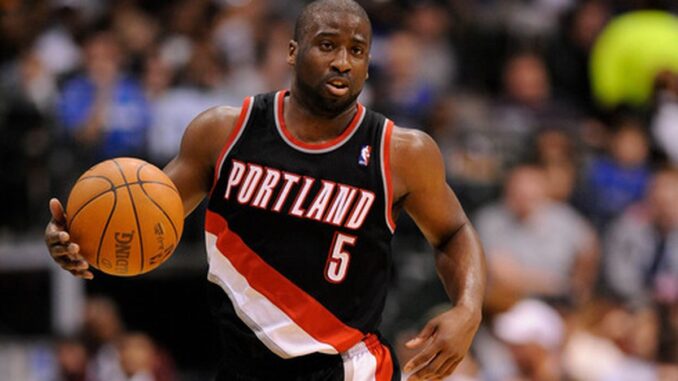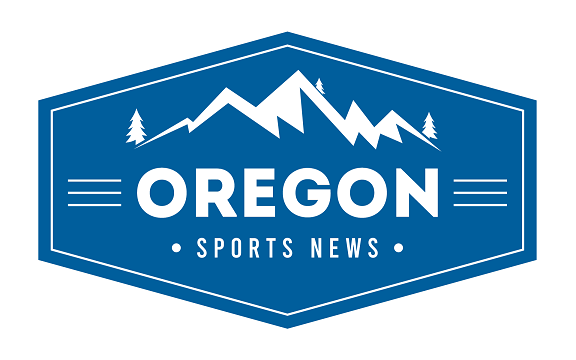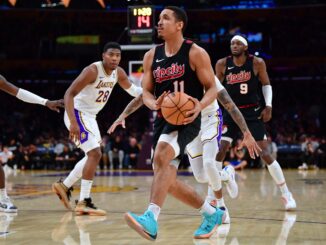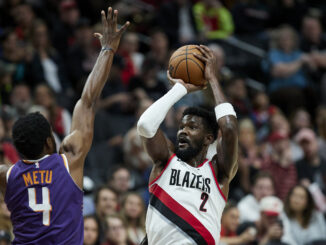
For a team with a lifetime winning percentage of .525, it’s not as easy to find heartache in their history as you might think. They may not have been a perennial title contender in every era, but this is one of the best regular season teams since the ABA-NBA merger in 1976.
The Blazers are going through some growing pains currently, and it’s definitely been one of the more frustrating times to be alive as a Blazers fan. There isn’t a clear answer about who the star they are building around, if the next five years will be better than the last five, who the head coach will be, or who will be owning and running the team, for that matter.
With so much up in the air for the team and so little happening in the win column, we wondered—what were the lowest points for fans during previous Trail Blazers eras?
1970-1976
BK: In a bizarre twist to start this exercise, I would’ve loved to have been around for this era, even though it didn’t come with many wins. The team managed just a .289 winning percentage through the franchise’s first four seasons. It also went through three coaches in those four years, eventually giving Lenny Wilkens a shot before Dr. Jack finally arrived in 1976-77.
Simply put: Winning basketball wasn’t a thing. But this period was also the beginning, the peak, and the prime of the original Trail Blazer, Geoff Petrie. He was as skilled as it came then and could score with the best of the league’s guards.
Of course, the excitement surrounding Petrie was short-lived, which became a theme for Portland stars throughout the years. Hence why, as much fun as Petrie would’ve been to watch play, this first six-year stint in Blazers history goes down as forgettable nearly 55 years later.
CM: Whoever was brave enough to dive in as one of the first Blazers fans has my respect and my questions about how you got through it—and kept on going.
Portland’s first season was one to forget; they won just 29 games under first-year head coach Rolland Todd – who had never coached or played professional basketball before, clearly the guy you want leading a brand new team. Geoff Petrie was great as their first pick in the draft and exactly the kind of player you want to build a roster around.
They added rookie of the year Sidney Wicks in 1971 and gave Stu Inman a shot at coaching. With Petrie hurt, they won just 18 games.
‘72 should have been one of the turning points, but it was more bad basketball without the ragtime whistling to go with it. Number one overall pick, LaRue Martin, was a double-double machine in college but was not an effective player at the pro level and struggled to score or get rebounds in a league led by big men, and the team struggled their way to 21 wins.
‘73 started poorly as Portland’s first-round pick Barry Parkhill signed with the ABA. Things didn’t go better from there as they finished with just 27 wins, another year with no answers to a lot of questions.
Then everything changed. NCAA superstar Bill Walton went to Portland with the number one pick, and he immediately scored at least 15 points with at least 13 rebounds in his first five games. He only played 35 games under player-coach Lenny Wilkens, but the team came very close to breaking even with 38 wins.
Portland took Lionel Hollins and Bob Gross in the 1975 draft. They won just 37 games under full-time coach Wilkens, but the table was set for what they would do in the coming years. The pain and suffering were almost at an end. Dr. Jack arrived the following year, along with Maurice Lucas and the most important trophy in the building.
1979-1982
BK: Unlike the previous depressing era, I’m plenty fine not having lived through this one. The basketball Gods really did Rip City dirty here, not just dooming Bill Walton’s foot but ripping away what would’ve…should’ve … could’ve been a dynasty.
Following the 1977 title and Bill Walton’s 1978 MVP season, things turned drastically from dynasty-in-the-making to downright mediocre. Walton’s and Lucas’s time in Portland came to an end. Thus began the first time in franchise history that the team was neither great nor a disaster.
This was the team’s “Welcome to the Middle” moment. A moment that, you might argue, has reared its ugly head too many times in Trail Blazers history.
CM: I can only imagine how frustrating it must have been to see Walton sitting out the entire season in 1979 after what should have been back-to-back championships in 1977 and 1978. I get why he did it, and no one knows what kind of player he could have been that year. The next few years playing in another uniform didn’t make you think he would have been terrific on one leg, but seeing the team reach the pinnacle and then topple down the mountain they just finished climbing is just sickening. Then your best player wins a fight with the team and signs with the Clippers, but they get nothing in return. Trading away Moses Malone right after taking him in the dispersal draft in 1976 never looked worse.
Getting center Mychal Thompson in the 1978 draft should have been the boost that pushed them back to being a contender, but the team around him just never seemed to gel the way they did with Walton, and part of that was Thompson just wasn’t an all-world defender like Walton was. Lucas was traded to the Nets, and the new-look Blazers were underway in 1981, featuring a core of Thompson and young guard Jim Paxson. They made the playoffs most years and put up a lot of points, but they just weren’t ready to face elite teams when the time came. In the playoffs following the 1982-83 season, they won their first playoff series since their championship run but were sent home by the Lakers in just five games in the next round.
They didn’t draft Clyde Drexler until 1983 and didn’t go on a deep playoff run for another six years after that. Bryant is correct. Wanting to fast-forward through this chapter is the right move, as it was one to forget.
1995-1998
BK: The P.J. Carlesimo era was a prime example of being stuck in the middle. Portland made the playoffs all three years he coached, and Carlesimo’s overall winning percentage was a solid .557. The number that mattered, though, was 0—as in, Zero playoff series wins against three first-round losses.
The playoff losing streak continued into Mike Dunleavy’s first season in 1997-98, making it six straight first-round losses in total. That’s rough having to watch 82 regular-season games just to fall in five games or fewer so many years in a row.
CM: The 1990 and 1992 Finals teams were officially gone. Drexler did not suit up for Portland in a season for the first time since 1983, Terry Porter was in Minnesota, Jerome Kersey and former head coach Rick Adelman were in Golden State, and Buck Williams was in New York.
Guys like Rod Strickland, Aaron McKie, Harvey Grant, and Chris Dudley took over. It felt like the team had toppled down the mountain they had just finished climbing all over again. They didn’t just get sent home by the Pistons, Bulls, and Lakers; they got sent back to 1980. This was a team that couldn’t contend and wasn’t bad enough to get a top draft pick. It was the worst way to be for a team that needed fresh talent now.
Help would arrive in a hurry and disappear almost as quickly. It was a window that was thrown open and slammed shut in a matter of two NBA seasons, which may actually be a record only the Kings have broken – and it was in the same time period.
2003-2007
BK: This is what you might think of as the post-Jail Blazers era, but really, most of it was the post-contending portion of the Jail Blazers era. It took most of these four years to re-do the roster, and not a single playoff berth was clinched to show for it.
Thinking back on these days, the most endearing qualities were some of the players themselves. Shareef Abdur-Rahim and Theo Ratliff made appearances. Joel Przybilla joined Rip City. And, of course, Steve Blake’s presence helped usher in a true near era near the end.
Unfortunately, the team racked up a ton of losses, figuring out its direction.
Sound familiar? I guess history really does repeat itself.
CM: This was probably the least disappointing thing I felt about going into a rebuild. The previous team was a lot of fun and traded punches with the best in the business, but they arrived and departed so quickly that I didn’t really have time to establish a lasting relationship with them. The negativity surrounding a team that hadn’t won anything didn’t make it any easier, and the feeling that no team was going to take down the Lakers or Spurs made it tough to feel like you had a fighter’s chance.
Coming out of this dark period, we got Brandon Roy and LaMarcus Aldridge, and for a short time, we even had Greg Oden, Joel Przybilla, and Nic Batum, so it was hard to be really mad about the guys who filled the previous chapter for a little while.
2011-2013
BK: When it comes down to it, Rip City would’ve never experienced Dame Time had it not been for the way things unraveled the year prior. That’s a fact. But I can’t help but think back on this time and still agonize over a 2011-12 season that was supposed to be something special.
Entering the year, Portland sat just outside the top 10 in championship odds. But by February, the veteran-led roster blew up in flames when the team traded Marcus Camby and Gerald Wallace, released Greg Oden, and fired Nate McMillan, all on deadline day. The added non-move to retain both Raymond Felton and Jamal Crawford felt odd, making everything about the end of that season uncomfortable for interim head coach Kaleb Canales.
CM: 2011 was a year that sucked, to put it lightly. Roy retires after one of the most epic playoff performances in the history of playoffs or performances. Oden was cut, and Nate McMillian was fired. And the team only won 28 games in a strike-shortened season. The draft was awful (NOLAN SMITH? WHAT??), and they just did not have IT that year.
Wes Matthews was a bright spot, taking over for Roy, but rounding out the roster with Luke Babbitt, fat Raymond Felton, and old, so old Kurt Thomas just felt like we were back in 1980 again. Why do they always send us back to 1980?
Damian Lillard arrived in 2012, and while that was no small miracle, some recall him making an immediate impact, turning Portland back into a contender. That was actually the following year, in 2013. Lillard did make an immediate impact, playing lights out and winning rookie of the year. But the team struggled with fill-in players Victor Clavor and Joel Freeland, and rookie center Meyers Leonard proved to be even more of a project than anticipated.
Fans distracted themselves by imagining that Elliott Williams would be their next superstar, but Williams never took off and became a historic footnote, spending more time with trainers than on the court.



